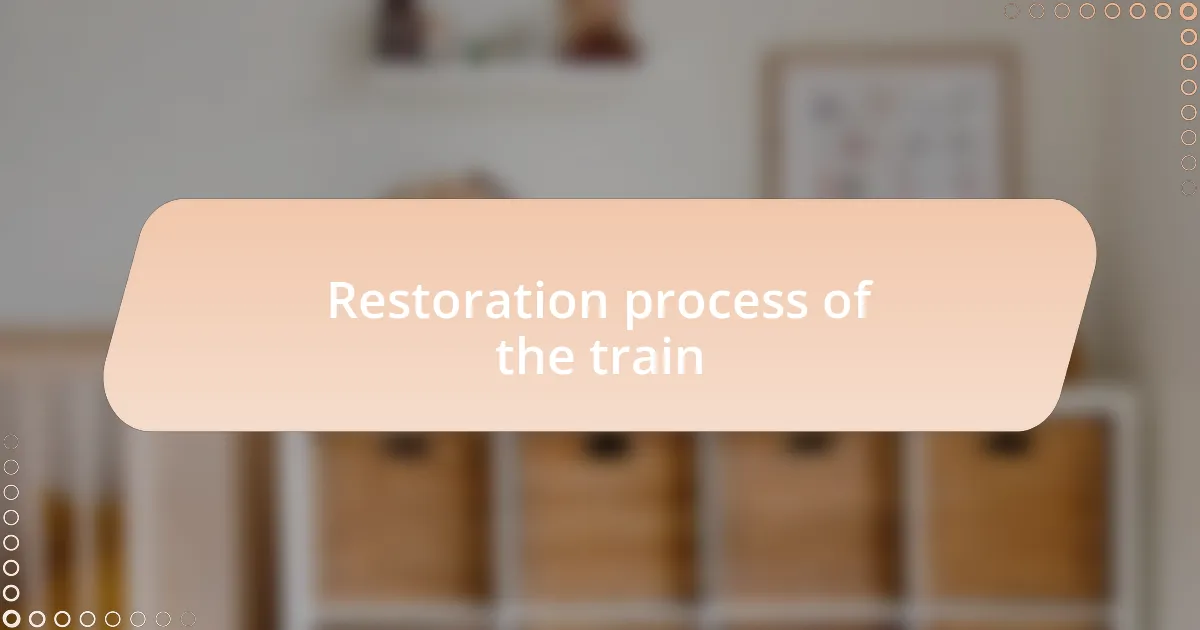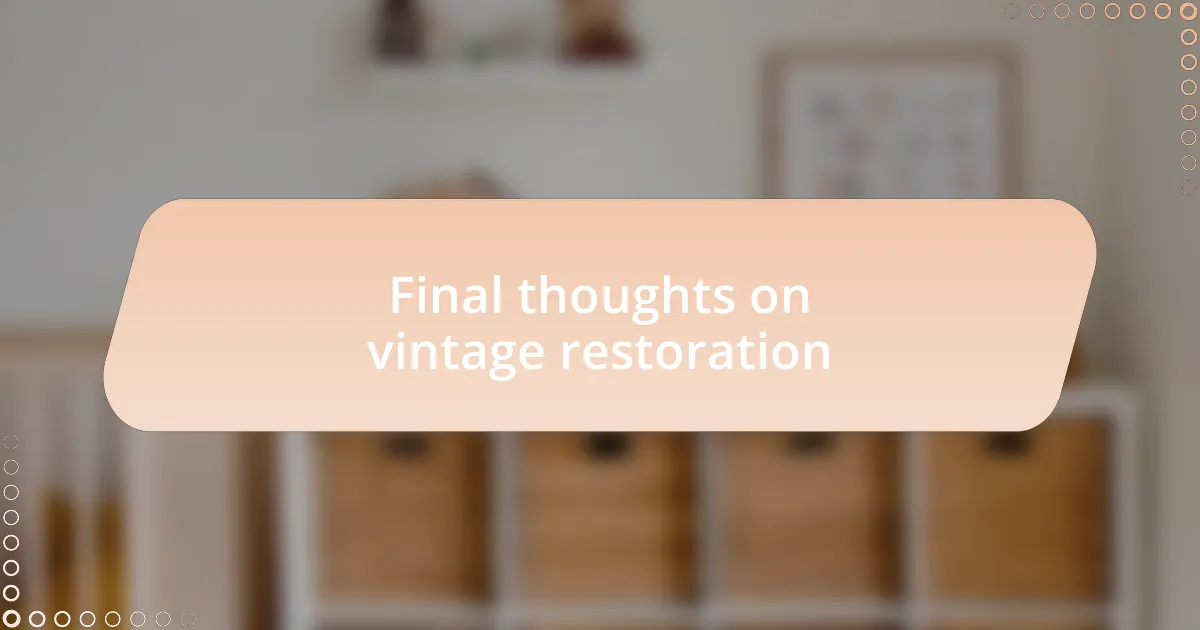Key takeaways:
- Vintage toys evoke nostalgia and reflect historical and cultural contexts, serving as emotional connections between generations.
- Restoration of vintage toys is an act of preserving family history and craftsmanship, allowing stories and memories to endure.
- Assessing the condition of a toy involves examining its exterior, wheels, and internal components to identify necessary repairs.
- The restoration process is deeply personal, involving careful cleaning, painting, and reassembly, resulting in a revival of cherished family memories.

Understanding vintage toys
When I think about vintage toys, I often remember the excitement I felt as a child unwrapping a gift that transported me to a different world. These toys were not just objects; they held stories and memories, from the clunky sound of a train rolling across tracks to the intricate details of a dollhouse that mirrored my own home. Have you ever held a vintage toy and felt that rush of nostalgia? It’s as if each scratch, each bit of wear, has its own tale to tell.
Understanding vintage toys goes beyond mere appreciation for their craftsmanship; it’s about recognizing their historical context. Many of these toys reflect the culture of their time, showcasing everything from design trends to social norms. For instance, I once came across a tin toy train that was not only beautifully painted but also representative of the industrial age’s fascination with trains. It made me reflect on how toy designs often echoed what was happening in the world outside.
Additionally, the emotional connection tied to vintage toys can be profound. I recall restoring a wooden toy that my grandfather played with as a child. The sense of continuity and the bridge between generations filled me with warmth. When you hold these pieces of history, you’re not just holding a toy; you’re cradling a piece of someone else’s childhood, a little fragment of history waiting to be cherished once more. How could you not feel a sense of responsibility to preserve that?

Importance of toy restoration
Restoring vintage toys, like my grandfather’s beloved train set, serves a purpose that goes beyond aesthetics. Each restoration project allows us to breathe new life into items that once sparked joy in children’s hearts, ensuring their stories continue to live on for future generations. When I worked on my grandfather’s train, I realized that fixing it wasn’t just about getting it to run again; it was an act of preserving family history.
Through restoration, we also foster a deeper appreciation for craftsmanship and design from the past. As I sanded down the scratched wooden surfaces of my grandfather’s train, the details began to emerge, revealing the skill that went into creating such a cherished toy. Isn’t it fascinating to think about the hands that crafted these toys, their attention to detail reflecting the care and love behind it?
Moreover, the emotional connections we build through restoring toys can be incredibly powerful. I often find myself reminiscing about the laughter and playtime associated with these toys, especially when I see the joy on a child’s face as they interact with something that has so much history. Isn’t that a remarkable way to bridge generations and share stories that might otherwise be lost?

Tools needed for restoration
Restoring a vintage toy train requires a few essential tools that can make the process smoother and more enjoyable. I found that a precision screwdriver set became my best friend, as the tiny screws on the train needed just the right tool to avoid stripping them. There’s something satisfying about each click of the screwdriver, especially when you finally loosen a screw that’s been stubborn for years.
In addition to screwdrivers, I discovered that having a cleaning kit on hand is crucial. I used cotton swabs and mild soap to gently clean the intricate parts without damaging the delicate finish. It reminded me of how careful my grandfather was with his belongings; every swipe felt like I was channeling his spirit, ensuring the train was in pristine condition for the next generation to enjoy.
Finally, I can’t stress enough the value of a good pair of pliers and a sturdy workbench. As I used the pliers to carefully reattach wires and parts, I was struck by how restoring this train connected me to my grandfather. It was more than just fixing a toy; it was a way to honor his legacy while creating new memories of my own. Don’t you think that the right tools can make these emotional journeys even more meaningful?

Steps to assess condition
To properly assess the condition of my grandfather’s toy train, I first took a close look at the exterior. I ran my fingers along the body, feeling for dents, rust, or scratches. Surprisingly, those little imperfections told stories, each one a testament to the adventures this train had seen. It made me wonder: how many holidays had it celebrated, chugging around our family’s Christmas tree?
Next, I examined the wheels and tracks meticulously. This was where I found the most telling signs of wear. A wheel that wobbled or didn’t turn freely hinted at deeper issues, perhaps even the need for replacement parts. The first time I discovered a rusty wheel, I felt a wave of nostalgia wash over me; it was a bittersweet reminder that even beloved toys have their challenges, just like us.
Finally, I checked the internal components, which is where the real magic happens. Carefully removing the casings, I inspected the motor and wiring for signs of damage. When I saw frayed wires or corrosion, my heart sank a bit. But I also felt empowered; knowing that with patience and the right tools, I could breathe new life back into this cherished piece of my family history felt incredibly rewarding. Don’t you think restoring something so steeped in memory is a way to keep those memories alive?
My grandfather’s toy train story
The toy train, a gift from my grandfather to my father, carried the spirit of childhood within it. I vividly remember my dad sharing stories of how he would excitedly set it up during family gatherings, the way it seemed to embody joy and laughter in every chug and puff of smoke. Each tale was infused with warmth, making me feel connected to those bygone days filled with simple pleasures.
As I studied the train, I could almost hear my grandfather’s voice echoing through time. He had a knack for storytelling, transforming the mundane into magical moments. Picking up the train, I could envision him leaning over the tracks, offering my dad tips on how to keep it running smoothly. How many times had they worked side by side, lost in an afternoon of tinkering and bonding? It touched me to realize that restoring this toy wasn’t just about fixing metal and wires; it was about reviving the memories my family cherished.
In the delicate process of cleaning and restoring, I felt a deep connection to my grandfather’s legacy. I poured over every detail—the faded paint, the chipped edges—and imagined the laughter that surrounded this tiny locomotive. With every stroke of my cloth, I wasn’t just polishing a train but also polishing the history it carried. Isn’t it remarkable how a simple toy can serve as a vessel for our memories, keeping our loved ones alive in our hearts?

Restoration process of the train
When I first examined the train, I realized its restoration would require patience and an eye for detail. I meticulously disassembled each component, taking pictures as I went along so I wouldn’t lose track. I found myself pondering—could these worn gears, so tainted by rust, still have life in them? As I cleaned them, I felt a sense of hope that I might breathe life back into this cherished relic.
The painting process was particularly emotional for me. I chose colors that closely matched the original, carefully layering the paint to revive its vibrant hues. Each brushstroke felt like a small act of love, a tribute to the joy it once brought to my father as a child. Reflecting on how many moments this little train made special, I couldn’t help but smile—could something so small carry such significant memories?
Reassembling the train was like piecing together a family puzzle. As I placed the last screw, a wave of excitement washed over me. I couldn’t wait to see it in motion again! I connected the wires and held my breath, wondering if it would run smoothly. When it finally chugged back to life, the sound echoed with laughter from years gone by—it was as if the train itself celebrated its return with me.

Final thoughts on vintage restoration
Vintage restoration isn’t just about fixing something old; it’s a heartfelt journey that connects generations. I remember the moment I set the restored train on the tracks for the first time. The sound of its wheels gliding over the rails stirred a nostalgia that made me think: isn’t this what true legacy feels like?
Each restoration project is unique, almost like a puzzle where the pieces tell a story. As I worked on my grandfather’s toy train, I realized the emotional benefits of bringing these treasures back to life. It wasn’t just about aesthetics; it was about honoring the memories tied to them. Isn’t it fascinating how the quirks and imperfections of these toys reflect the lives they touched?
In the end, the true value of vintage restoration lies in the love and effort we invest in these pieces. When I saw the train sparkle under the sunlight, I understood that I wasn’t merely restoring a toy. I was reviving a part of my family’s history. Isn’t that a beautiful reminder of our shared past?